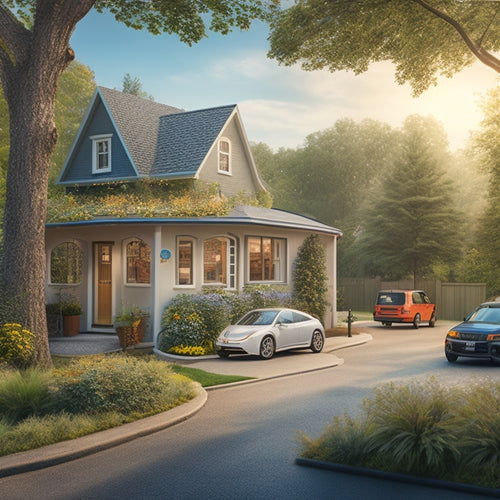
Mastering Blind Spot Detection in Your SUV
Share
As you rely on advanced driver assistance systems in your SUV, understanding blind spot detection is vital for enhancing vehicle safety and minimizing accident risks. Electric SUV designs can create unique blind spot challenges, making sensor calibration and maintenance essential. Advanced radar and lidar sensor systems work together to detect obstacles, providing real-time data to your vehicle's computer. By understanding how blind spot detection works, you can optimize your system for accurate data collection and timely warnings, improving your overall driving experience. Now, explore the intricacies of configuring your BSD system to master blind spot detection in your SUV.
Key Takeaways
• Understand your SUV's blind spot detection range and adjust your driving accordingly, considering speed and environmental factors.
• Regularly clean and calibrate your sensors to ensure accurate blind spot detection and minimize false alerts.
• Use your rearview and side mirrors in conjunction with blind spot detection technology for enhanced awareness and safety.
• Develop strategies to anticipate and react to blind spots, such as checking mirrors and glancing over your shoulder.
• Stay informed about advancements in blind spot detection technology, including autonomous integration and augmented reality displays, to improve your driving experience.
Understanding Blind Spot Technology
Operating a vehicle safely requires awareness of its surroundings, which is where blind spot technology comes in, alerting you to potential hazards lurking in areas you can't see. As a driver, you rely on your mirrors and glances over your shoulder to stay informed, but even with diligent checks, blind spots can still pose a threat.
That's where advanced driver assistance systems come in, providing an added layer of vehicle safety. Blind spot detection technology uses sensors and cameras to monitor your surroundings, detecting vehicles in your blind spot and alerting you with visual, audible, or tactile warnings. This innovative feature is designed to reduce the risk of accidents, making you a more informed and defensive driver.
Electric SUV Blind Spot Challenges
As you move to an electric SUV, you'll encounter unique blind spot challenges that arise from the vehicle's distinct design features and advanced technology. The electric powertrain, for instance, often necessitates a revised SUV design, which can impact blind spot detection.
Additionally, the placement of charging infrastructure can create blind spots, particularly in urban areas where charging stations are often situated in tight spaces.
Here are three key electric SUV blind spot challenges to be aware of:
-
Rear quarter blind spots: The rear quarter windows of electric SUVs can be smaller due to the revised design, reducing visibility.
-
Charging infrastructure blind spots: Charging stations, especially in urban areas, can create blind spots due to their proximity to the road.
-
Sensor calibration: The advanced technology in electric SUVs requires precise sensor calibration to guarantee accurate blind spot detection, which can be impacted by the vehicle's unique design features.
Advanced Sensor Systems Explained
As you explore advanced sensor systems in your SUV, you'll encounter two key technologies: radar sensor technology and lidar scanning capabilities.
These sensors work in tandem to detect blind spots, providing a 360-degree view of your surroundings.
Radar Sensor Technology
Radar sensors, an important component of advanced sensor systems, use radio waves to detect obstacles and measure distances in your SUV's surroundings. They're designed to provide accurate data, even in harsh weather conditions or low-light environments.
As you drive, radar sensors continuously scan the area around your vehicle, detecting potential hazards and alerting you to potential blind spots.
To maintain peak performance, it's crucial to:
-
Regularly calibrate your radar sensors to uphold accuracy and prevent false readings.
-
Inspect sensors for signs of damage or wear, replacing them as needed to ensure durability.
-
Keep sensors clean and free from debris, which can interfere with signal reception.
Lidar Scanning Capabilities
Your SUV's advanced sensor system employs lidar scanning capabilities to create detailed, thorough 3D point clouds, allowing it to accurately detect and respond to its surroundings. This technology uses laser light to scan the environment, generating a precise, three-dimensional image of the area around your vehicle.
The lidar resolution is exceptional, capturing even the smallest details, such as lane markings and obstacles. The scanning patterns are strategically designed to cover a wide range of angles and distances, ensuring extensive coverage of your blind spots.
As you drive, the lidar system continuously updates its scan, providing real-time data to your SUV's computer. This information is then used to detect potential hazards, such as vehicles in your blind spot, and alert you accordingly.
The precision and accuracy of lidar scanning capabilities make it an essential component of your SUV's advanced sensor system, providing an added layer of safety and confidence on the road. By combining lidar with other sensor technologies, your SUV can provide a complete picture of its surroundings, helping you stay safe and aware on the road.
How Blind Spot Detection Works
You depend on a combination of sensors and software to detect vehicles in your blind spot, which typically includes a pair of rear-quarter sensors and a processing unit that analyzes the data in real-time. This sophisticated system enables your SUV to constantly monitor the areas adjacent to your vehicle, guaranteeing your safety on the road.
Here's how it works:
-
Sensor calibration methods are used to guarantee accurate data collection from the rear-quarter sensors.
-
The system performs blind zone analysis, identifying potential hazards in your blind spot.
-
The processing unit analyzes the data and alerts you of potential dangers through visual, auditory, or tactile warnings.
This advanced technology allows you to stay focused on the road ahead, confident that your SUV has your back – or rather, your blind spot. By understanding how blind spot detection works, you can better appreciate the safety features designed to protect you and your passengers.
Avoiding Accidents With BSD
By leveraging the advanced capabilities of blind spot detection, drivers can greatly decrease the risk of accidents and near-misses on the road. You'll be able to drive more confidently, knowing that your vehicle is actively monitoring your blind spots and alerting you to potential hazards. This is especially significant when it comes to defensive driving, where being aware of your surroundings is vital.
When changing lanes or merging onto a busy highway, blind spot detection can be a lifesaver. You'll receive timely warnings if another vehicle is lurking in your blind spot, allowing you to adjust your driving accordingly. This leads to safe merging, reducing the risk of collisions and near-misses. With BSD, you can focus on the road ahead, knowing that your vehicle has got your back.
Benefits of Blind Spot Monitoring
Blind spot monitoring offers a multitude of benefits, including enhanced safety, reduced driver stress, and improved overall driving experience. As you cruise down the highway, you'll appreciate the added layer of protection provided by this advanced safety feature. With blind spot monitoring, you'll drive with increased confidence, knowing that your vehicle has your back.
Here are just a few ways this technology benefits you:
-
Enhanced Safety: Blind spot monitoring acts as a safety net, alerting you to potential hazards in your blind spots, reducing the risk of accidents and near-misses.
-
Driver Confidence: With this feature, you'll feel more confident behind the wheel, knowing that you've got an extra set of eyes watching out for you.
-
Reduced Stress: By minimizing the risk of accidents, blind spot monitoring helps reduce driver stress, making your time on the road more enjoyable and relaxing.
Configuring Your BSD System
Its advanced sensors and cameras require precise calibration to optimize the performance of your Blind Spot Detection (BSD) system.
To get the most out of your BSD system, you'll need to configure it to your vehicle and driving habits. Start by consulting your owner's manual for specific calibration instructions, as the process may vary depending on your vehicle's make and model.
During system calibration, you'll need to adjust the sensors and cameras to accurately detect your vehicle's blind spots. This process typically involves driving your vehicle at a slow speed while the system learns your vehicle's dimensions and blind spot zones.
Once calibrated, you can customize your BSD system to fit your user preferences. You may want to adjust the sensitivity of the system or set the alert threshold to minimize false alarms.
Blind Spot Detection Range
After configuring your BSD system, you need to comprehend the blind spot detection range to maximize its effectiveness. This range determines the area where your SUV's sensors can detect other vehicles or obstacles. A clear understanding of this range helps you anticipate potential blind spots and adjust your driving accordingly.
Here are three key aspects to take into account when evaluating your blind spot detection range:
-
Sensor Calibration: Make sure your sensors are properly calibrated to detect objects within the designated range. Incorrect calibration can lead to inaccurate readings or false alarms.
-
Distance Threshold: Understand the distance threshold at which your BSD system alerts you to potential hazards. This threshold varies depending on your vehicle's speed and the surrounding environment.
-
Environmental Factors: Be conscious of environmental factors that can affect your BSD system's performance, such as weather conditions, road debris, or construction zones.
Overcoming Blind Spot Limitations
While maneuvering through complex road scenarios, you'll inevitably encounter limitations in your SUV's blind spot detection system. It's important to develop strategies to compensate for these shortcomings.
One important aspect is driver awareness. Stay vigilant and continually check your rearview and side mirrors to stay informed about your surroundings. This heightened awareness will help you anticipate potential blind spots and react accordingly.
Regular vehicle maintenance is also important in optimizing your blind spot detection system. Make sure that your SUV's sensors are clean and free from debris, as dirt and grime can impede their functionality. Additionally, have your system calibrated periodically to ensure it's operating within ideal parameters.
Future of Blind Spot Detection
As you continue to rely on your SUV's blind spot detection system, you're likely wondering what advancements are on the horizon to further enhance safety and convenience. The future of blind spot detection holds much promise, with several innovative technologies poised to revolutionize the way we drive.
Here are three key developments to look out for:
-
Autonomous Integration:
As autonomous vehicles become more prevalent, blind spot detection will play a critical role in enabling safe and efficient autonomous driving. Expect to see advanced sensors and software working in tandem to detect and respond to potential hazards. -
Augmented Reality Displays:
Future blind spot detection systems may incorporate augmented reality (AR) displays, providing drivers with a more intuitive and immersive experience. AR overlays can project essential information, such as blind spot alerts, directly onto the windshield or side mirrors. -
Advanced Sensor Fusion:
Next-generation blind spot detection will likely involve the fusion of multiple sensors, including cameras, radar, and lidar. This sensor fusion will enable more accurate and reliable detection, even in complex driving scenarios.
These advancements won't only improve safety but also enhance the overall driving experience. As you look to the future of blind spot detection, you can expect a more seamless and intuitive experience behind the wheel.
Frequently Asked Questions
Can I Customize My BSD System to Recognize Specific Trailer Sizes?
You can customize your BSD system to recognize specific trailer sizes using trailer profiling and sensor calibration, allowing you to tailor the system to your unique towing needs and improve overall detection accuracy.
How Often Should I Update My BSD Software for Optimal Performance?
Picture driving on a winding road, surrounded by dense fog, depending on your trusty BSD system. To guarantee seamless performance, you should update your BSD software every 6-12 months, prioritizing software maintenance for system optimization.
Can BSD Systems Be Installed as an Aftermarket Accessory?
When considering a BSD system installation as an aftermarket accessory, you'll need to weigh installation costs against potential warranty implications, ensuring a seamless integration that doesn't void your SUV's warranty.
Are BSD Systems Affected by Weather Conditions Like Heavy Rain or Fog?
When you're driving in harsh weather, you might wonder if your trusty BSD system is still on the job. The truth is, heavy rain or fog can affect sensor calibration, causing weather interference that might compromise its accuracy.
Can BSD Systems Detect Pedestrians or Cyclists in the Blind Spot?
You'll be relieved to know that advanced BSD systems can detect pedestrians and cyclists in your blind spot, prioritizing pedestrian safety and cyclist awareness, even in low-visibility conditions, thanks to advanced sensors and algorithms.
Related Posts
-

Why Nearby EV Conversion Shops Matter to You
Having a nearby EV conversion shop means you'll experience the benefits of a more personalized, convenient, and susta...
-

3 Best State and Local Solar Incentives USA
You can greatly reduce your energy dependence and save thousands of dollars by taking advantage of the top state and ...
-

Best Solar Panel Options for Maximum Energy Savings
You can maximize your energy savings with solar panels that boast efficiency ratings above 20%, paired with extensive...


